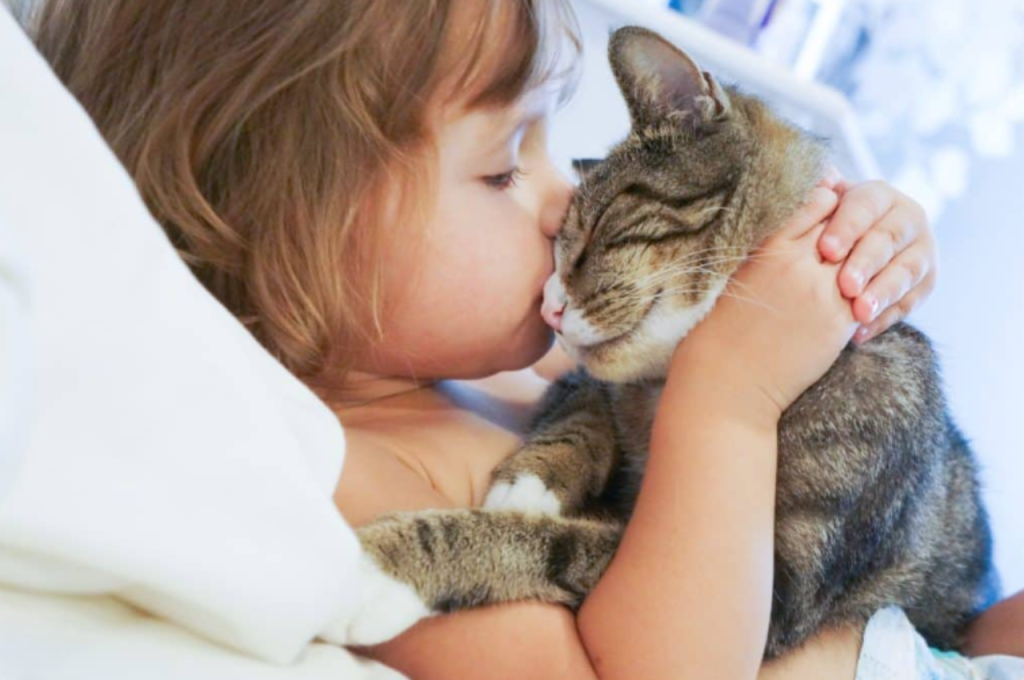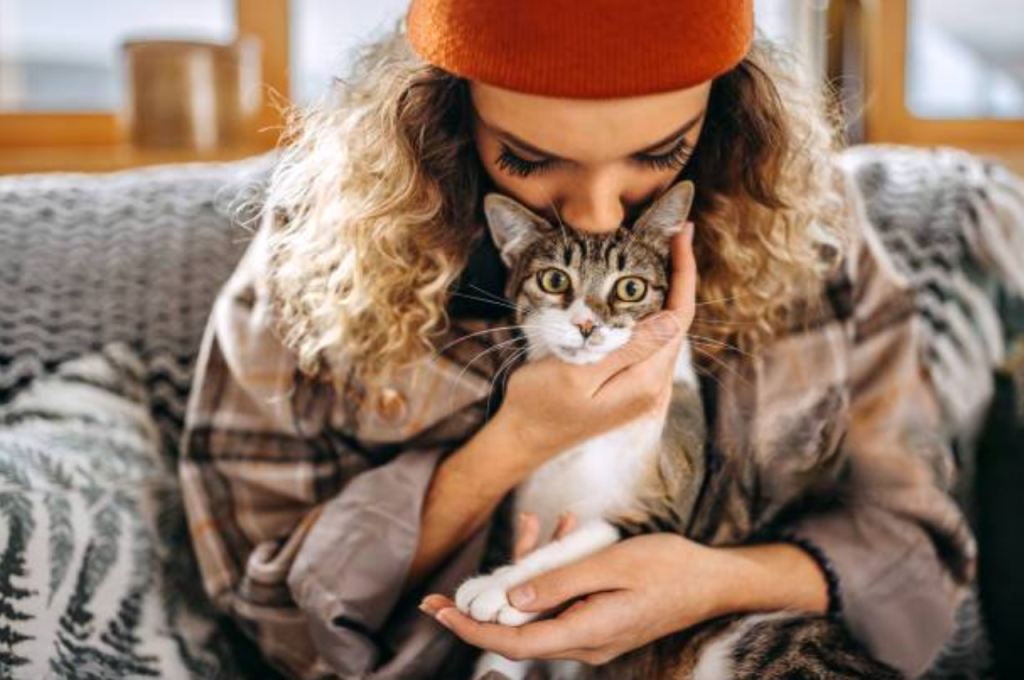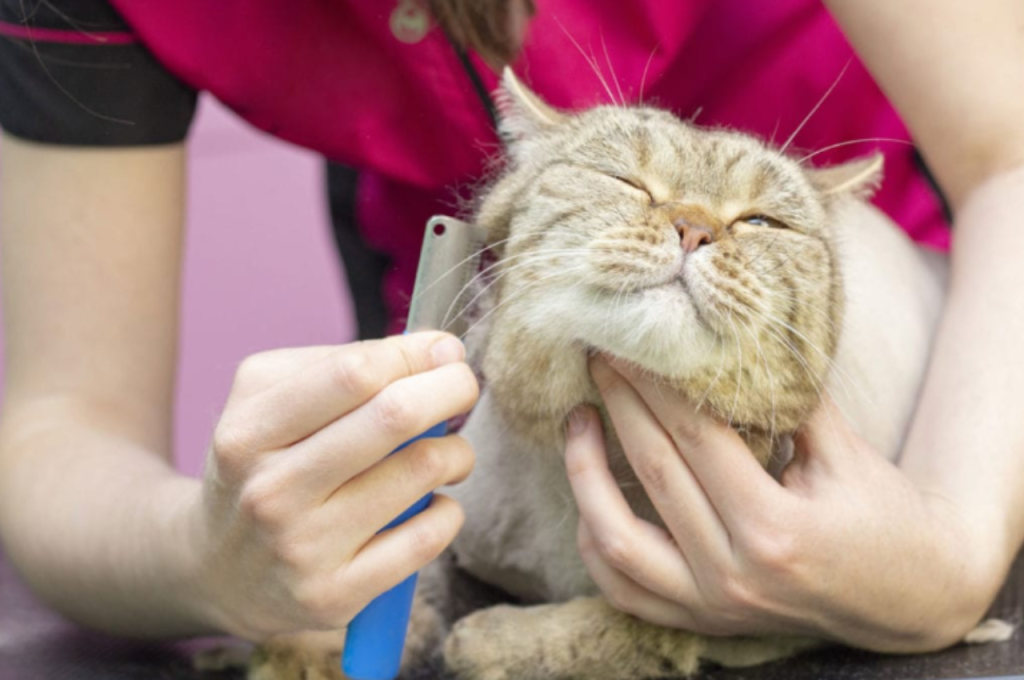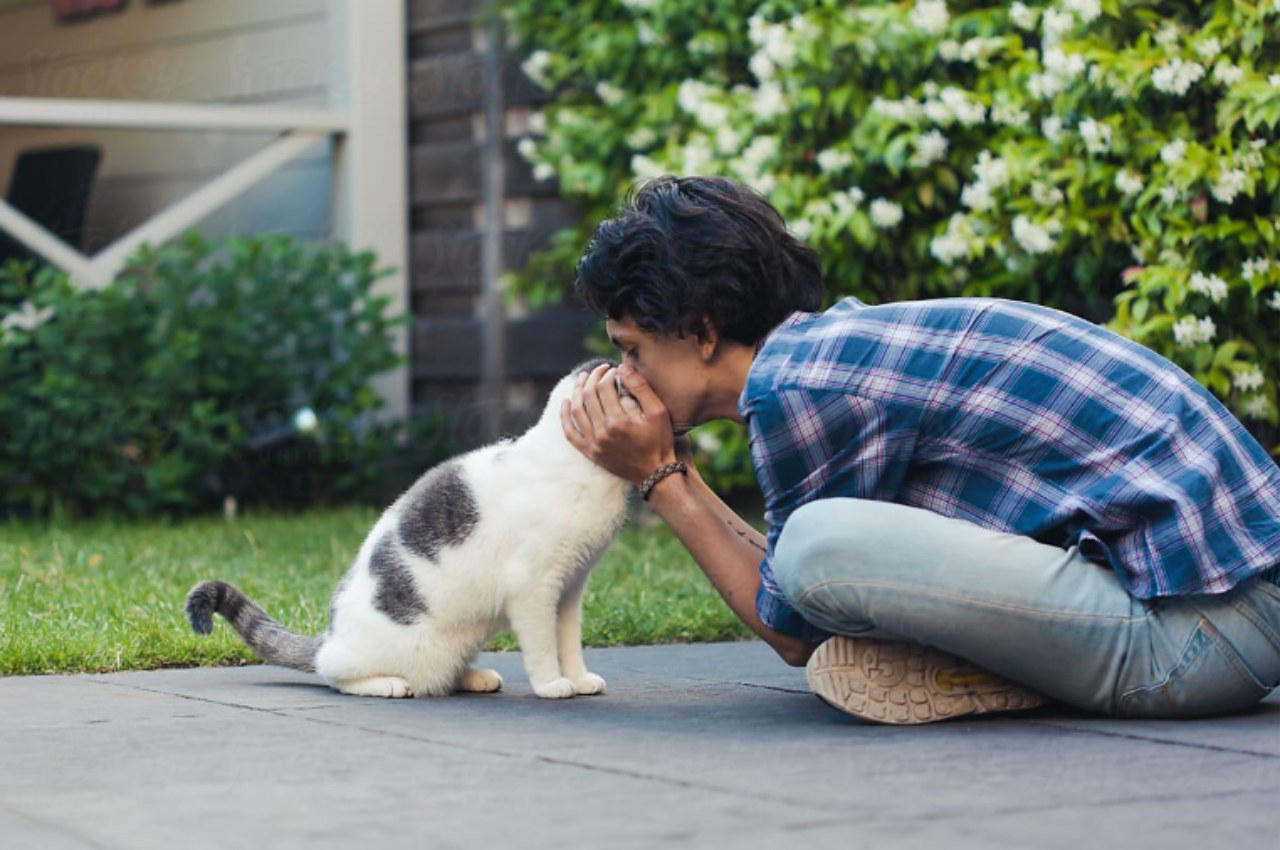It is generally safe to kiss your cat on the head, but there are a few considerations to keep in mind. Kissing your cat on the head can be a sweet way to show affection, but whether it’s okay or not depends on the individual cat’s temperament and preferences.
Some cats may enjoy the attention and feel comforted by the gesture, while others may find it stressful or intrusive. Before going in for a smooch, take note of your cat’s body language and mood. If they seem relaxed, and receptive and enjoy being petted and cuddled, a gentle kiss on their head will likely be well-received.
However, if your cat shows signs of anxiety or discomfort, such as flattening their ears, swishing their tail, or trying to move away, it’s best to respect their space and find alternative ways to express your love and affection. Understanding your cat’s individual preferences is key to maintaining a happy and harmonious relationship.
The Significance of Cat Head Bunting
In the feline world, head bunting is a form of communication that serves a crucial role in building bonds between cats and their human companions. Cats express affection through head bunting by gently pressing their heads against objects or individuals. This behavior is a way for cats to mark their territory with scent glands located in their cheeks.

- Head bunting signifies trust and social bonding.
- It is a non-verbal way for cats to communicate emotions.
Understanding Cat Head Bunting Behavior allows us to interpret our feline friends’ feelings and deepen our relationship with them.
| Benefits of Cat Head Bunting | Interpretation |
| Strengthening the bond | Showing trust and affection |
| Exchange of scents | Creating a familiar environment |
Health Implications of Kissing A Cat On the Head
Kissing your cat on the head may seem like a harmless display of affection, but it’s essential to consider the potential health implications for both you and your feline friend. Here are some health considerations to keep in mind:
Potential Risks of Intimate Contact
Kissing your cat on the head may pose certain risks to your health due to potential exposure to bacteria, parasites, and allergens.
Zoonotic Diseases and Transmission Risks
There is a possibility of contracting zoonotic diseases from your cat through close contact, including kissing on the head.
Building A Trusting Relationship with Your Cat
Developing a trusting bond with your cat involves understanding their boundaries. While some cats may enjoy head kisses, others may not. Picking up on your cat’s cues and respecting their preferences fosters a strong and loving relationship.
Importance of Establishing Trust
Trust is the foundation of any relationship, and that includes the one you have with your cat. Establishing trust is crucial because it helps your cat feel safe and secure in your presence. When your cat trusts you, they are more likely to exhibit positive behaviors and engage in social interaction with you. This can lead to a happier and healthier cat.
Building trust with your cat involves patience, consistency, and understanding. Regular playtime sessions, respectful handling, and providing a safe environment are some of the key factors in developing trust. By being reliable, understanding your cat’s needs, and respecting their boundaries, you can create a strong foundation of trust.
Alternative Ways to Show Affection
While kissing your cat on the head may not be the most appropriate way to show affection, there are plenty of other ways to express your love for your feline friend. Here are some alternative ways:
1. Gentle Petting: Cats love to be petted, but it’s important to be gentle and aware of their preferences. Pay attention to how your cat reacts to different types of strokes and adjust your petting technique accordingly.
2. Interactive Play: Engaging in playtime activities, such as chasing a toy or using a laser pointer, not only provides mental and physical stimulation for your cat but also strengthens your bond. Remember to use toys that allow your cat to exhibit their natural hunting instincts.
3. Offering Treats: Providing your cat with treats as a reward for good behavior or simply as a gesture of affection can go a long way in building trust. Choose healthy, cat-approved treats and offer them in moderation.
4. Quiet Quality Time: Set aside a quiet and calm space for you and your cat to relax together. Sitting quietly in their presence and allowing them to approach you on their terms can help foster trust and deepen your connection.
5. Respect Boundaries: Just like humans, cats have their boundaries. It’s important to recognize signs of discomfort or stress and give them the space they need. Avoid forcing interactions and allow your cat to initiate contact.
6. Grooming: Some cats enjoy being groomed, which can further strengthen your relationship. Use a soft brush or comb and take your time to groom your cat gently. This can be not only a bonding activity but also a way to keep their coat healthy.
Remember, each cat is unique and may have different preferences when it comes to showing and receiving affection. By understanding and respecting your cat’s individual needs, you can build a trusting and loving relationship that will last a lifetime.
Respecting Your Cat’s Boundaries
Respecting your cat’s boundaries is essential for maintaining a healthy and positive relationship with your feline friend. While showing affection by kissing your cat on the head may seem harmless, it’s important to understand and respect your cat’s preferences and comfort levels.

Recognizing Signs of Discomfort
If your cat displays signs of discomfort such as flattening their ears, flicking their tail, or trying to move away when you attempt to kiss them, it’s crucial to recognize and respect these signals. Cats communicate their boundaries through subtle body language, and it’s important to pay attention to their cues to avoid causing stress or discomfort.
Creating A Safe Environment for Your Cat
Creating a safe and comfortable environment for your cat is paramount. This includes providing them with a quiet and calm space where they can retreat when they need solitude. Additionally, offering your cat plenty of enrichment and play opportunities can help alleviate potential stress and anxiety, contributing to a healthier and happier relationship between you and your pet.
Cultural Perspectives on Cat Affection
Cultural perspectives on cat affection reveal interesting insights into the ways different societies view cat-human relationships. From historical views to modern practices, the way people interact with cats varies across cultures. Let’s explore some of these fascinating cultural perspectives.
Cats in Different Cultures
Cats have been revered in various cultures throughout history. In ancient Egypt, they were considered sacred and were associated with the goddess Bastet. In Japan, cats are believed to bring good luck and prosperity. On the other hand, some cultures view cats as symbols of bad luck or even evil spirits. These diverse cultural attitudes toward cats shape the way people express affection toward them.
Historical Views On Human-animal Relationships
Throughout history, humans have had complex relationships with animals. In ancient times, animals were often worshipped or revered for their perceived mystical qualities. As societies evolved, animals came to be seen as companions and sources of comfort. These historical perspectives inform the way different cultures approach showing affection to pets, including cats.
Expert Opinions On Cat-owner Interaction
Many cat owners enjoy showing affection to their feline friends by kissing them on the head. However, there is some debate about whether this is a suitable behavior. To provide clarity on the matter, let’s explore the insights from veterinarians and recommendations from behaviorists regarding the interaction between cats and their owners.
Veterinarians’ Insights
Veterinarians emphasize the importance of understanding a cat’s body language and individual preferences. They advise that not all cats enjoy physical contact, including head kisses. While some cats may tolerate or even appreciate this display of affection, others might find it uncomfortable or unsettling. Veterinarians encourage cat owners to pay attention to their cat’s cues and respect their boundaries to maintain a healthy and positive relationship.
Behaviorists’ Recommendations
Behaviorists stress the significance of establishing trust and creating a safe environment for cats. They recommend that cat owners gradually introduce physical interactions, including head kisses, to ensure the cat feels secure and reassuring. By observing the cat’s response and adjusting their approach accordingly, owners can build a strong bond while promoting the cat’s well-being.
Ensuring A Positive Experience for Both You and Your Cat
Discover whether it’s safe to kiss your beloved feline on the head and ensure a positive experience for both you and your cat. Understand the implications and take necessary precautions for the well-being of your furry friend.
Ensuring a Positive Experience for Both You and Your Cat is crucial when it comes to interacting with your feline friend. Proper understanding and respect for your cat’s preferences can lead to a harmonious relationship. Tailoring your interactions to suit your cat’s needs can create a mutually beneficial bond.
Mutual Benefits of Interaction
Kissing your cat on the head can foster trust and strengthen your emotional connection. Affectionate gestures can improve your cat’s overall well-being.
Tailoring Interaction to Your Cat’s Preferences
Understanding your cat’s body language is essential. Some cats enjoy head kisses, while others may prefer gentle petting. Observing your cat’s reactions can guide your interactions.
• Use positive reinforcement to encourage desirable behavior.
• Create a safe and comfortable environment for your cat.
• Respect your cat’s boundaries and give them space when needed. Maintaining a positive experience for you and your cat revolves around communication and mutual respect.
By catering to your cat’s preferences and ensuring they feel safe and loved, you can strengthen your bond and create a happy and harmonious relationship.
Alternatives to Kissing Your Cat on the Head
Discover alternative ways to show affection to your cat besides kissing on the head. Options include gentle pets, chin scratches, and interactive play sessions to bond with your feline friend. It’s important to respect your cat’s boundaries and preferences for physical affection.
If you’re someone who loves to show affection to your feline friend, you may wonder if it’s okay to kiss your cat on the head. While some cats may tolerate this gesture, it’s important to remember that cats are different from humans and have their preferences for physical interaction.
Instead of kissing your cat on the head, there are alternative ways to show your love and build a strong bond with your furry companion. In this article, we’ll explore a few alternatives that will help you engage with your cat in a way that they appreciate and enjoy.
Interactive Play Sessions
One of the best alternatives to kissing your cat on the head is to engage them in interactive play sessions. Cats are natural hunters and love to chase and pounce on moving objects. By providing them with interactive toys, such as feather wands or laser pointers, you can stimulate their hunting instincts and create a fun and engaging experience for both you and your cat.
During play sessions, make sure to let your cat initiate the play and allow them to set the pace. Use quick, erratic movements to mimic the behavior of prey, and encourage your cat’s natural hunting behaviors by rewarding them with treats or praise when they successfully catch their “prey.”
Grooming and Petting Techniques
Another way to bond with your cat without kissing them on the head is through grooming and petting sessions. Cats spend a significant amount of time grooming themselves, so gentle brushing or combing can provide a soothing and enjoyable experience for them.

When grooming your cat, start with short sessions and gradually increase the duration as your cat becomes more comfortable. Use a brush or comb specifically designed for cats, and be mindful of sensitive areas such as the belly or tail. If your cat shows signs of discomfort or stress, such as hissing, growling, or trying to escape, respect their boundaries and give them space.
In addition to grooming, petting can also be a wonderful way to show affection. Most cats enjoy being petted on the chin, cheeks, and under the chin, as these are areas where their scent glands are located. Use gentle strokes and observe your cat’s body language to ensure they’re enjoying the interaction.
Remember that every cat is unique, and their preferences for physical interaction may vary. Understanding your cat’s body language and respecting their boundaries is crucial for building a strong and trusting relationship with them.
Conclusion
Ultimately, whether or not it is okay to kiss your cat on the head boils down to individual preference and your cat’s comfort level. While some cats may enjoy physical affection, others may not appreciate it as much. It is important to pay attention to your cat’s body language and respect their boundaries.
Remember, there are many other ways to show your feline friend love and affection without necessarily kissing their head. Understanding and prioritizing your cat’s needs is the key to building a strong and trusting bond with them. So, go ahead and show your love in ways that both you and your furry companion are comfortable with.
